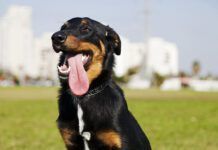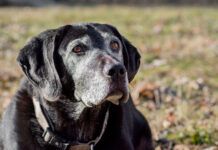You may hear people talk about a surgery called a “gastropexy,” which is done if a dog has bloat. Some dog owners request a prophylactic gastropexy if they have a bloat-prone breed.
What is gastropexy? Gastropexy is a surgical procedure done to “tack” or attach the stomach to the body wall, so it can’t flip or twist. Bloat—a dangerous condition technically called “gastric dilatation and volvulus (GVD)”—is when the dog’s stomach fills with gas and twists. It is life-threatening. If the stomach flips, the odds of a good outcome go down dramatically. See “Bloat in Dogs Is Deadly.”
How Is Gastropexy Done?
Different surgical techniques are used to do gastropexy, but the goal is the same: Develop a permanent attachment of the stomach to the right abdominal wall to hold the stomach in place. This surgery reduces the likelihood of a bloat recurrence from 55% to 4%.
The original technique used stomach-wall flaps that were anchored to a rib. The attachments healed well, but there were often complications.
The current preferred technique fuses an incision in the gastric wall to a matching incision in the abdominal wall. This is a fast procedure, and while slightly weaker than the stomach-wall wrap version, is still very successful.
Twisted Stomach in Dogs
Many, if not most, gastropexies are performed as part of surgical correction for a bloat, especially if there has been a partial or total twist of the stomach. Your dog has had the torsion fixed, tissues including stomach, spleen, and intestines have been checked for any necrotic (dead) tissue, all vital signs are stabilized, and your veterinarian hopes to prevent a recurrence.
Prophylactic Gastropexy in Dogs
Many owners of bloat-prone breeds, such as Setters, Great Danes, German Shepherd Dogs, and even Dachshunds due to their deep chests, will elect to have a prophylactic gastropexy done to hopefully prevent a case of bloat or torsion ever happening. This can easily be combined with spay or neuter surgery, so your dog only has one round of anesthesia. While the procedure may not prevent basic bloat, it should keep the stomach from torsing.
Initially, there were concerns that gastropexy might interfere with normal gastrointestinal motility, but most experienced veterinary surgeons feel this is not the case.
Bloat Prevention in Dogs
An increased risk of bloat has been linked to:
- History of bloat in a particular breed line (hints to a possible genetic predisposition)
- Dogs who eat too fast (ingest excess air with the meal)
- Using elevated feeding bowls (promotes ingestion of excess air with the meal)
- Feeding dry food with heavy fat/oil content
- Feeding a large meal vs. multiple smaller meals
- Exercising on a full stomach
- Drinking excessive amounts of water at one time
It’s smart to be careful about how your dog eats and drinks. Try to:
- Feed small meals frequently.
- Keep your dog quiet after eating.
- If your dog has been running hard, limit his water intake to small amounts. So, let him drink, walk him a bit, let him drink again, etc.
- Do not use elevated food or water bowls.
- Try to minimize stress. Heavy panting may allow your dog to “gulp” a lot of air and predispose to bloat.
There is not much you can do about conformation, so breeds with narrow and deep chests will always have a higher risk. The World Association of Small animal Veterinarians says the lifetime risk for a large or giant breed dog developing GDV is 24% and 21%.
Know the initial signs of bloat, which include:
- Pacing
- Panting
- Drooling
- Trying to vomit but nothing coming up
- Abdominal distension
Consider these signs of an emergency and head for the nearest veterinary emergency clinic and alert them that you are on your way with a possible bloat.
My 12-year-old male Belgian Tervuren was in surgery in less than an hour from the first sign I saw of bloat. Thankfully, the clinic was close by and when I got him there, they were ready. He came through from a partial torsion with flying colors and his gastropexy is well healed by now.






